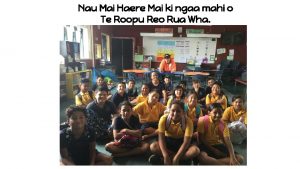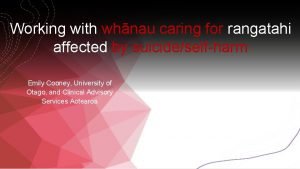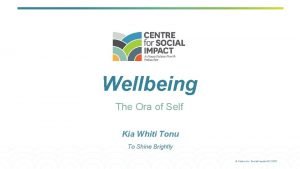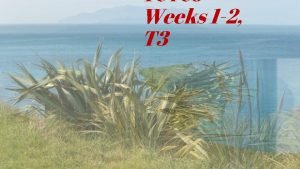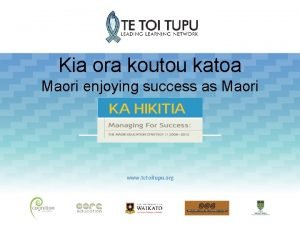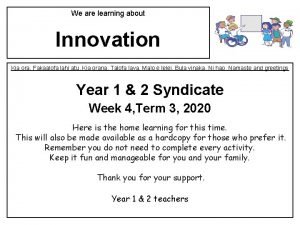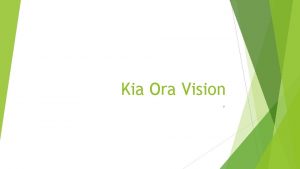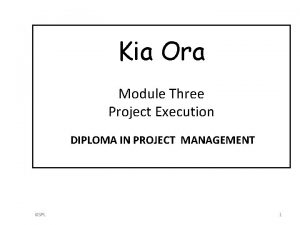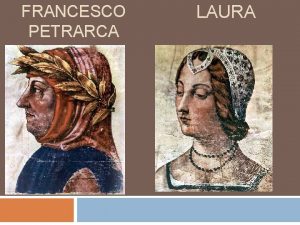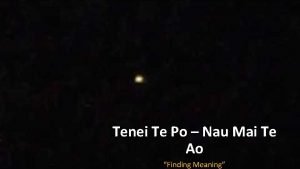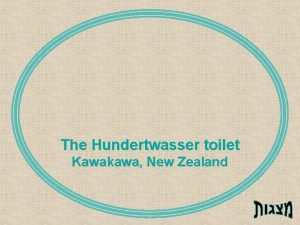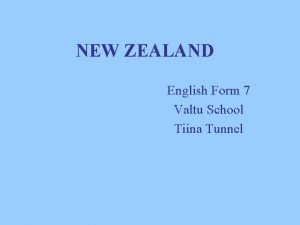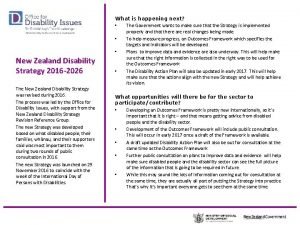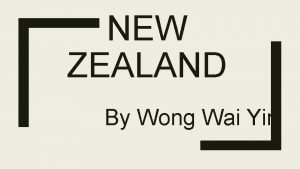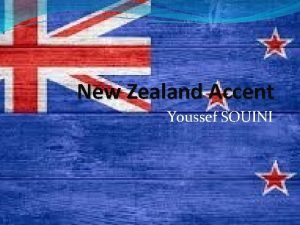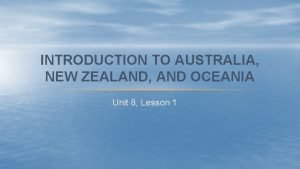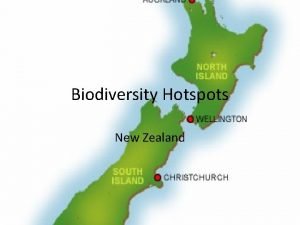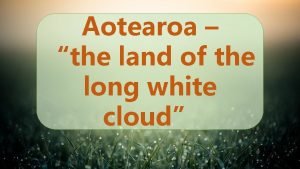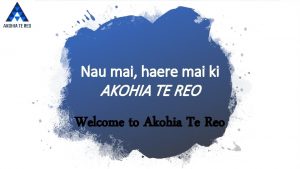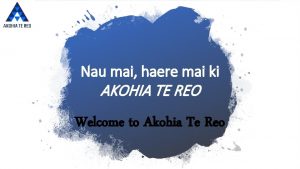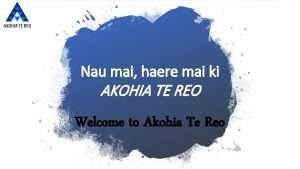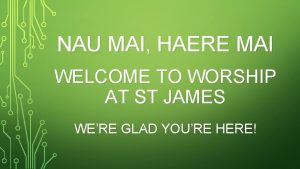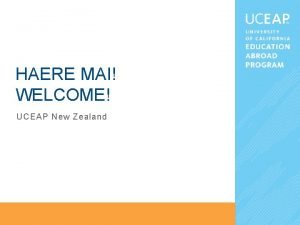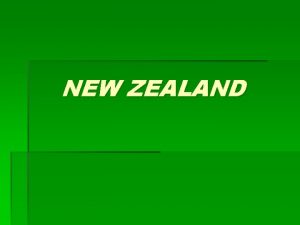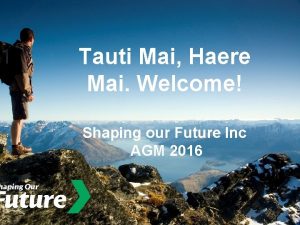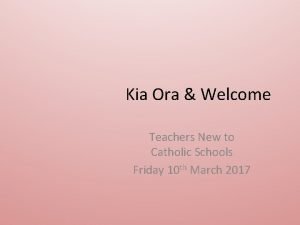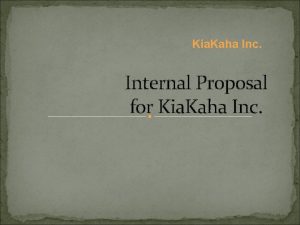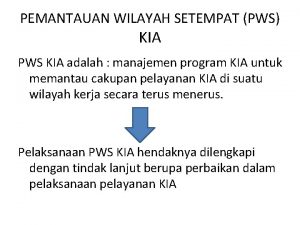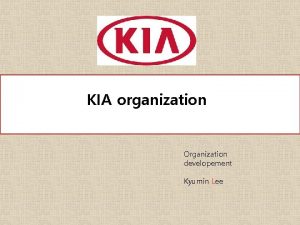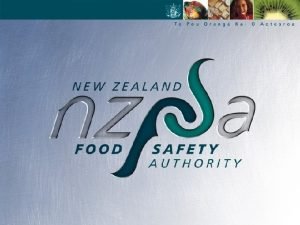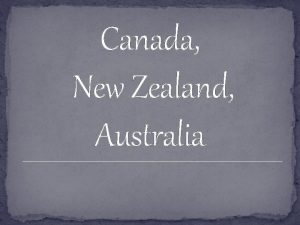New Zealand Education Kia ora nau mai haere

























- Slides: 25

New Zealand Education “Kia ora, nau mai, haere mai ki te Tahuhu o Te Matauranga” Holly Ayers Spring 2010

• “The Youngest Country” • A developed nation with a high living standard, low unemployment and a diversified economy. • One of the world’s top 25 “innovator economies” • Known for its independent position on nuclear energy, foreign policy, environmental sustainability and conservation

Demographic Context • Location – Pacific nation, located SW of Australia • Area – 270. 534 sq km (104, 454 sq miles) • Population – 4. 3 Million (UN, 2009) • Capital – Wellington (North Island) • Largest City – Auckland (South Island) • Government – Queen Elizabeth II – Prime Minister: John Key BBC News –Timeline: New Zealand. (n. d. ). Retrieved March 1, 2010, from http: //news. bbc. co. uk/2/hi/asiapacific/1138430. stm

Demographic Context • Money – 1 New Zealand Dollar=100 NZ Cents< $1 USD – GNI per capita=$27, 940 USD – Agriculture, Manufacturing, Tourism, Film • Main Exports – Wool, Food/Dairy, Wood/Paper Products • Official Languages – English, Maori , NZ Sign Language • Religion – Christianity • Life Expectancy – 78 years (men), 82 years (women) BBC News –Timeline: New Zealand. (n. d. ). Retrieved March 1, 2010, from http: //news. bbc. co. uk/2/hi/asiapacific/1138430. stm

Demographic Context • Literacy – – Definition: age 15 and over can read and write Total population: 99% Male: 99% Female: 99% (2003 est. ) • School Life Expentancy – Total: 19 years – Male: 19 years – Female: 20 years (2006) • Educational Expenditure – 6. 2% of GDP (2006) – Country comparison to the world: 38 CIA-The World Fact Book-New Zealand (n. d. ). Retrieved March 1, 2010, from https: //www. cia. gov/library/publications/the-world-factbook/geos/nz. html

History • • • c. 1000 AD - Maori arrive from other parts of Polynesia. 1642 - Dutch explorer Abel Tasman visits New Zealand. 1769 - British captain James Cook explores coastline, also in 1773 and 1777. 1815 - First British missionaries arrive. 1840 - Treaty of Waitangi between British and several Maori tribes pledges protection of Maori land establishes British rule. 1845 -72 - The New Zealand Wars (Land Wars). Maori put up resistance to British colonial rule. 1893 - New Zealand becomes world's first country to give women the right to vote. 1898 - Government introduces old-age pensions. 1907 - New Zealand becomes dominion within British Empire. BBC News –Timeline: New Zealand. (n. d. ). Retrieved March 1, 2010, from http: //news. bbc. co. uk/2/hi/asia-pacific/1138430. stm

HIstory Independence • 1947 - New Zealand gains full independence from Britain. • Plans to nationalise coastline sparked Maori protests • 1984 - Labour government elected, Prime Minister David Lange begins radical economic reforms. • 1993 - Referendum vote introduces proportional representation. • 1996 - Under new electoral system, number of Maori MPs rises from six to 15. • 1997 - Jenny Shipley becomes New Zealand's first woman prime minister. • 1998 - Waitangi Tribunal orders government to return confiscated land in Turangi Township to its Maori owners. BBC News –Timeline: New Zealand. (n. d. ). Retrieved March 1, 2010, from http: //news. bbc. co. uk/2/hi/asia-pacific/1138430. stm

History • • • 2002 June - Prime Minister Helen Clark apologises to Samoa for New Zealand's poor treatment of its citizens in colonial times. The apology is made at a ceremony in Samoa marking 40 years of independence. 2004 May - Intense debate over proposed bill to nationalise sea bed. Maori protesters say bill would infringe ancestral rights. 2004 December - New Zealand China begin talks on a potentially-lucrative free trade agreement. Parliament passes bill which recognizes civil unions between gay couples. BBC News –Timeline: New Zealand. (n. d. ). Retrieved March 1, 2010, from http: //news. bbc. co. uk/2/hi/asia-pacific/1138430. stm

History • • • 2008 September - New Zealand's economy goes into recession for the first time since 1998. 2009 March - Official figures show the New Zealand economy shrank at its fastest rate in 17 years in the last three months of 2008. 2009 June - New Zealand's economy shrinks for the fifth consecutive quarter, making it officially the longest recession in the country's history. 2009 November - New Zealand's unemployment rate hits a nineyear high of 6. 5% in the third quarter as the economy sheds 17, 000 jobs. 2010 –National Compulsory Education Standards BBC News –Timeline: New Zealand. (n. d. ). Retrieved March 1, 2010, from http: //news. bbc. co. uk/2/hi/asia-pacific/1138430. stm

Educational History • 1877 -Education Act makes primary education free. Education becomes compulsory from ages 7 -14. • 1914 -Education Act makes secondary school free to all who pass a proficiency examination. • The Thomas Report addresses the egalitarian education system and called for equalization in education for technical high schools. • 1980’s- 1990’s-Widespread educational reform calls for a curriculum review, but ends in administration-based reforms. • Department of Education is replaced with a Ministry of Education – 1988 -Picot Report and Tomorrow Schools • 2010 -National Standards for compulsory literacy and numeracy BBC News –Timeline: New Zealand. (n. d. ). Retrieved March 1, 2010, from http: //news. bbc. co. uk/2/hi/asia-pacific/1138430. stm

Educational Structure Ministry of Education (2008). New Zealand education system: An overview. (n. d). Retrieved March 1, 2010 from http: //www. minedu. govt. nz/~/media/Min. Edu/Files/Education. Sectors/International. Education/For. International. Students. A nd. Parents/NZEd. Sys. Overview. pdf

International Benchmarking • Strengths – 99% Literacy rate – 77% aged 25 -64 completed secondary or tertiary qualifications (well above the OECD average of 67%) – Proportion of adults with a bachelors degree or higher rose from 8% to 20% between 1991 and 2005. – 15 year old students perform well above the OECD mean in reading, math and scientific literacy. • Weaknesses – Average achievement is high, but New Zealand should target and increase achievement in the lower achieving range, which is primarily comprised of Maori and Pacifika students. Ministry of Education (2008). New Zealand education system: An overview. (n. d). Retrieved March 1, 2010 from http: //www. minedu. govt. nz/~/media/Min. Edu/Files/Education. Sectors/International. Education/For. International. Students. And. Par ents/NZEd. Sys. Overview. pdf

Current Education Initiatives • • • Early Childhood Education Primary and Secondary Tertiary Ka Hikitia Pasifika Education Plan

Early Childhood Education • Government Reform Standards – Curriculum development-Te Whariki – Regulation: Minimum standards and teacher quality – Funding, support and initiatives • Funding – Partial government funding, not government owned or managed • Options – Whanau – Playcenters, Kohanga Reo, and A’oga Amata – Special education and distance learning Bignold, W. , & Gayton, L. (2009). Global issues and comparative education: Perspectives in education studies. Southernhay, England: Learning Matters.

School Education • Government Reform Standards – National Curriculum – National standards for compulsory literacy and numeracy • Funding – Free to NZ citizens or permanent residents ages 5 -19 years – Compulsory from 6 -16 years • Options – State schools, state integrated schools, private, boarding schools, Kura Kaupapa Maori, and wharekura • Special Education – Primarily integrated – Special schools for hearing or vision impaired

National Curriculum Vision Young people who will be confident, connected, actively involved, lifelong learners Learning Areas Values Excellence Innovation, Inquiry, Diversity, Equity, Community, Ecological Sustainability, Integrity, Respect Key Competencies Thinking, Using Language, Symbols and Texts, Relating to others, Participating and Contributing English, Arts, Health/PE, Math, Science, Social Sciences, Technology, Official Languages Achievement Objectives Principles High Expectation, Treaty of Waitangi, Cultural Diversity, Inclusion, Learning to Learn, Community Engagement, Coherence, Future Focus Ministry of Education (2008). New Zealand education system: An overview. (n. d). Retrieved March 1, 2010, from http: //www. minedu. govt. nz/~/media/Min. Edu/Files/Education. Sectors/International. Education/For. International. Students. A nd. Parents/NZEd. Sys. Overview. pd

National Standards Politics vs. Teachers

Curriculum Learning Areas English • Students study, use, and enjoy language and literature communicated orally, visually, or in writing The Arts • Student explore, refine, and communicate ideas as they connect thinking, imagination, sense, and feelings to create works and respond to the works of others Health and Physical Education • Students learn to about their own well-being, and that of others and society, in health-related and movement contexts Learning Languages • Students learn to communicate in an additional language, develop their capacity to learn further languages, and explore different world views in relation to their own Mathematics and Statistics • Student explore relationships in quantities, space, and data and learn to express these relationships in ways that help them make sense of the world around them. Science • Students explore how both the natural and physical world and science itself work so they can participate as critical, informed, and responsible citizens in a society in which science plays a significant role Social Sciences • Students explore how societies work and how they themselves can participate and take action as critical, informed, and responsible citizens Technology • Students learn to be innovative developers of products and systems and discerning consumers who will make a difference in the world

Tertiary Education • Degree Level – Universities (8) • Vocational Certificate/Degree Level – – Institutes of Technology Polytechnics (20 state owned) Private Training Establishments(700 -800) Industry Training Organizations (40 state owned) – Wananga (3) – Governmental Training Establishments (11)

University Education • Performance based funding • Undergraduate, Masters and Doctoral Programs • Required University Entrance standard • International comparability – British Bachelors degrees – Australian Bachelors degrees – US Bachelors degrees

Vocational Education • Upper secondary and university based • Practical teaching environments • Industry experienced teachers • Internships, cooperative learning or on-job training • Stackable programs, certificates and degrees • Flexible program delivery

Teacher Education • New Zealand Teachers Council • Every school teacher must be registered • ECE teachers-2012 goal • Tertiary does not require registration

Educational Statistics Comparison Indicator New Zealand Rank United States Rank Average Years of Schooling. Adults 11. 7 3/100 12 1/100 Class Size 20. 8 students 11/29 Compulsory Education-Years 12 11/171 12 12/171 Education Spending %GDP 6. 7% 21/132 5. 7% 39/132 Ed Attainment-Tertiary 29% 8/18 37% 2/18 Primary Teaching Salary $16, 678 18/22 $25, 707 5/22 Literacy-Total Population 99% 29/160 99% 20/160 Reading Literacy 529 3/27 504 15/27 Math Literacy 537 3/27 493 18/27 Scientific Literacy 528 7/27 499 14/27 Tertiary Enrollment 69. 2% 5/151 72. 6% 1/151 Nation. Master-New Zealand Education Statistics (n. d. ). Retrieved March 1, 2010, from http: //www. nationmaster. com/country/nz-new-zealand/edu-education Nation. Master- United States Education Statistics (n. d. ). Retrieved March 1, 2010, from http: //www. nationmaster. com/country/us-unitedstates/edu-education

New Zealand Education • Strengths – Holistic education focus – Local, self-governing education system – Global approach to higher education delivery and international community • Challenges – New compulsory national standards – Education, health, and economic disparities – Continued cultural unrest

References BBC News –Timeline: New Zealand. (n. d. ). Retrieved March 1, 2010, from http: //news. bbc. co. uk/2/hi/asia-pacific/1138430. stm Bignold, W. , & Gayton, L. (2009). Global issues and comparative education: Perspectives in education studies. Southernhay, England: Learning Matters. CIA-The World Fact Book-New Zealand (n. d. ). Retrieved March 1, 2010, from https: //www. cia. gov/library/publications/the-world-factbook/geos/nz. html Ministry of Education (2008). New Zealand education system: An overview. (n. d). Retrieved March 1, 2010, from http: //www. minedu. govt. nz/~/media/Min. Edu/Files/Education. Sectors/Internati onal. Education/For. International. Students. And. Parents/NZEd. Sys. Overview. pd Nation. Master-New Zealand Education Statistics (n. d. ). Retrieved March 1, 2010, from http: //www. nationmaster. com/country/nz-new-zealand/edueducation Nation. Master-United States Education Statistics (n. d. ). Retrieved March 1, 2010, from http: //www. nationmaster. com/country/us-united-states/edueducation
 Nau mai ki makara
Nau mai ki makara Kia ora education
Kia ora education Karakia opening
Karakia opening Kia tau kia tatou katoa karakia
Kia tau kia tatou katoa karakia Cầm tay nhau đi xem ai có giận hờn gì
Cầm tay nhau đi xem ai có giận hờn gì Whakatauki for death
Whakatauki for death Kia ora kotou katoa
Kia ora kotou katoa Kia ora training
Kia ora training Oravision
Oravision Heike gudat
Heike gudat Kia ora meaning
Kia ora meaning Pambuka pranatacara
Pambuka pranatacara L'oro et le perle e i fior' vermigli e i bianchi
L'oro et le perle e i fior' vermigli e i bianchi Francesco petrarca laura
Francesco petrarca laura I te po meaning
I te po meaning Mila nori
Mila nori Pe axa numerele mai mari sunt așezate mai mici
Pe axa numerele mai mari sunt așezate mai mici Hundertwasser toilet new zealand
Hundertwasser toilet new zealand New zealand national sport
New zealand national sport New zealand disability strategy
New zealand disability strategy When was new zealand discovered
When was new zealand discovered Difference between australian and new zealand accent
Difference between australian and new zealand accent Lesson 1 physical geography of australia and new zealand
Lesson 1 physical geography of australia and new zealand New zealand alpha lipid
New zealand alpha lipid New zealand hotspots
New zealand hotspots Aotearoa the land of the long white cloud
Aotearoa the land of the long white cloud
